Lion of Saint Mark

The Lion of Saint Mark, representing the evangelist St Mark, pictured in the form of a winged lion holding a Bible,[1] is the symbol of the city of Venice and formerly of the Republic of Venice. It appears also in both merchant and military naval flags of the Italian Republic. The Lion of Saint Mark is also the symbol of the award of the Venice Film Festival, the "Golden Lion", and of the insurance company Assicurazioni Generali.
Other elements often included in depictions of the lion include a halo over his head, a book, and a sword in its paws.
St Mark and Venice
Venetian tradition states that when St. Mark was traveling through Europe, he arrived at a lagoon in Venice, where an angel appeared to him and said "Pax tibi Marce, evangelista meus. Hic requiescet corpus tuum." (May Peace be with you, Mark, my evangelist. Here your body will rest.) This (possibly apocryphal) tradition was used as justification by Rustico da Torcello and Bon da Malamocco[2] in 828[3] for stealing the remains of St. Mark from his grave in Alexandria,[4] and moving them to Venice, where they were eventually interred in the Basilica of St. Mark.[5]

Symbolism
St Mark, represented as a lion, is a typical Christian iconography derived from the prophetic visions contained in the verse of the Apocalypse of St John 4:7. The lion is one of the four living creatures described in the book as a place around the throne of the Almighty and they are chosen as symbols of the four evangelists. These "beings" were previously described by the prophet Ezekiel.
"Behold, I send my messenger ahead of you, he will prepare your way."
The voice of the one who cries in the wilderness: "Prepare Ye the way of the Lord, make straight his paths." (Gospel according to Mark 1:1–3)
The lion also symbolizes the power of the Evangelist's word, the wings symbolize the spiritual elevation, while the halo is the traditional Christian symbol of holiness.
However, the lion symbols express also the significance of majesty and power (drawn especially from the upward feline tail), while the book expresses the concepts of wisdom and peace and the halo gives an image of religious piety.
There are many symbolic interpretations with the possible combination of sword and book:
- An open book is a symbol of the state's sovereignty (many depictions are of doges kneeling before such representation);
- A closed book, however, is considered as a symbol of a delegated sovereignty, and hence the public courts;
- An open book (and the sword on the ground is not visible) is popularly considered as a symbol of peace for the state of Venice, but this is not corroborated by any historical source;
- A closed book and a drawn sword are popular but mistakenly considered as a symbol of the state in war;
- Finally, an open book and a sword are considered as a symbol of public justice.
However, these interpretations are not universally accepted as the Republic of Venice (La Serenissima) never codified its symbols. Rare, but are presented, are also depictions of the lion without a book or a sword and sometimes without the halo (especially in a representation of a statue).
In some depictions the lion rests his front paws on the ground, often in cities with rivers or in ones close to water, indicating the Venetian balanced power on land and sea.
Depictions
The Venetian lion appears in two distinct forms. One is as a winged animal resting on water, to symbolise dominance over the seas, holding St. Mark’s Gospel under a front paw. You can see these mighty animals all round the Mediterranean, usually on top of a classical stone column.[6]
The other form is known as the lion “in moleca”, in the form of a crab. Here the lion is depicted full-faced with its wings circled around the head resembling the claws of a crustacean. It is emerging from water, so that the lion “in moleca” is associated with the lagoon and the city, whereas the standing winged lion is thought to be more associated with Venetian territory around the Mediterranean.[6]
Gallery
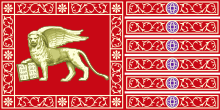 Flag of the Republic of Venice
Flag of the Republic of Venice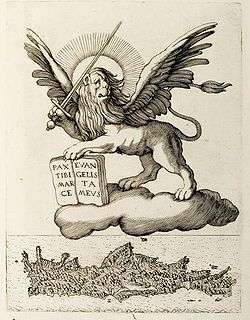 1651 map depicting the Lion of St Mark over Crete
1651 map depicting the Lion of St Mark over Crete
 Flag of the Republic of San Marco (1848)
Flag of the Republic of San Marco (1848) Jack of the Italian Navy
Jack of the Italian Navy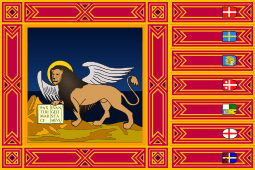 Flag of the Veneto Region
Flag of the Veneto Region Arms of Oberickelsheim
Arms of Oberickelsheim Coat of Arms of Pope John Paul I
Coat of Arms of Pope John Paul I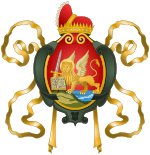 Coat of Arms of the Republic of Venice and present Coat of Arms of Venice
Coat of Arms of the Republic of Venice and present Coat of Arms of Venice Lion of St. Mark seen on the Venetian Coat of Arms
Lion of St. Mark seen on the Venetian Coat of Arms Arms of Marxzell
Arms of Marxzell.svg.png) Arms of Saint-Marc-Jaumegarde
Arms of Saint-Marc-Jaumegarde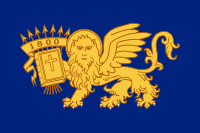 Flag of the Septinsular Republic
Flag of the Septinsular Republic Logo of the Uva College Badulla
Logo of the Uva College Badulla- Winged lion sculpture atop the Generali Building in Jerusalem
 Logo of Mark Rutherford School, Bedford, UK
Logo of Mark Rutherford School, Bedford, UK
References
| Wikimedia Commons has media related to Lion of Saint Mark. |
- ↑ "Lion Of Saint Mark". The Venice Wikibook. Retrieved August 26, 2011. External link in
|publisher=(help) - ↑ "Hellovenezia : The Lion of St. Mark". Retrieved August 31, 2011.
- ↑ "Flags of the World : Venice". Retrieved August 31, 2011.
- ↑ "A History of Venice". Retrieved August 31, 2011.
- ↑ "Venice Monuments". Retrieved August 31, 2011.
- 1 2 Robinson, Myra, "The Lions of Venice", Italy Magazine, July 14, 2011
External links
- Of Lions and Books (and Swords): an in-depth article about iconography of Lion of St Mark, explaining different meanings of open and closed books.